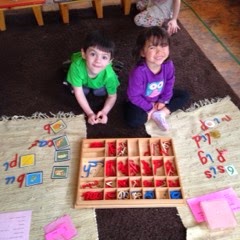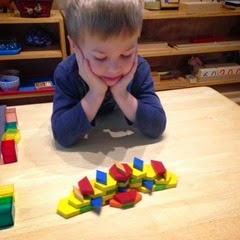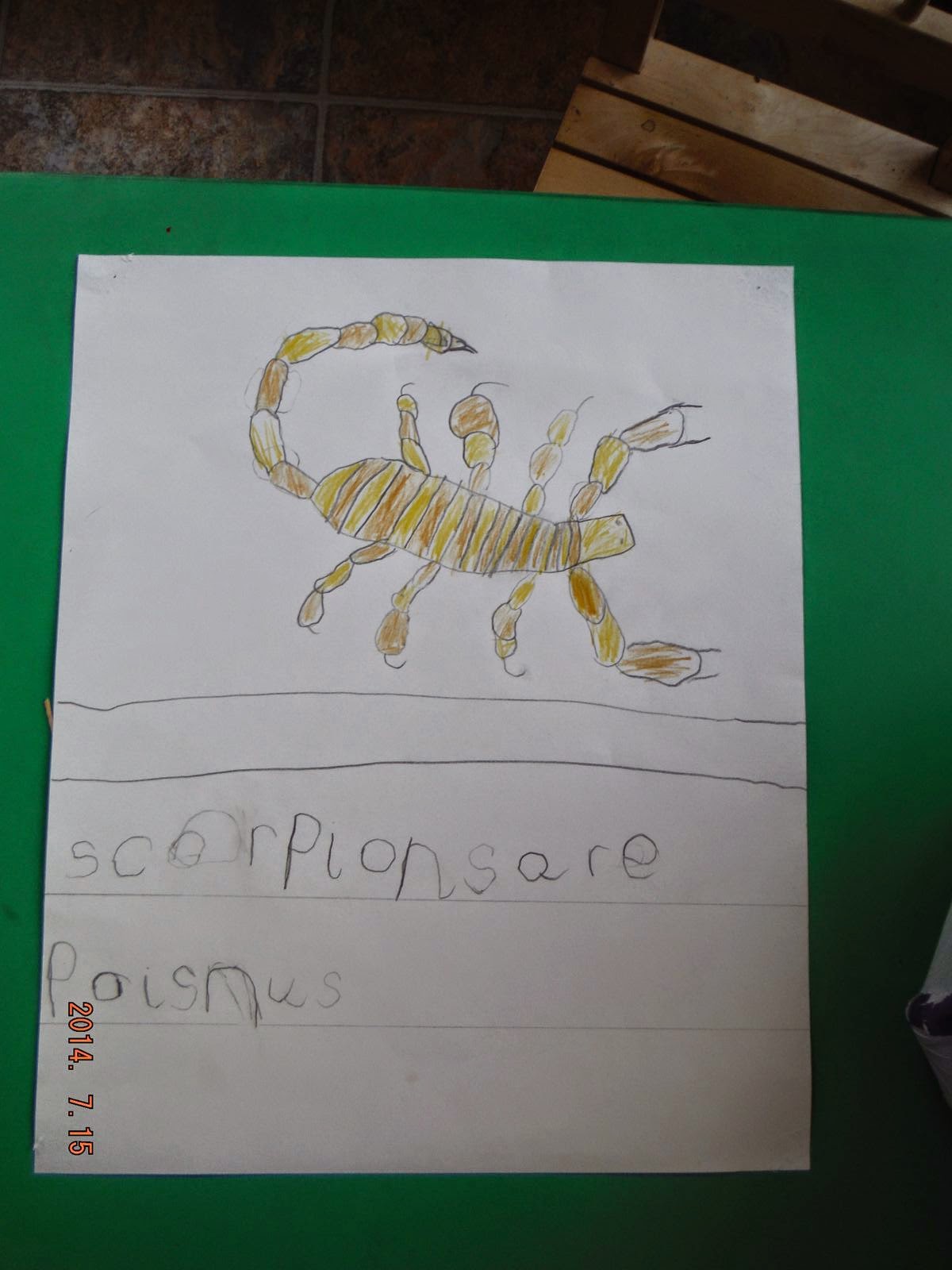"The first aim of the prepared environment is, as far as it is possible,
to render the growing child independent of the adult."
Maria Montessori
We are always humbled by the mystery inherent in the young child's daily choice of activities. We prepare the environment, paying attention to a thousand details, and day by day we introduce the children to a spread of activities that are suited to their age and development. Then we step back and observe what happens. Every day we are amazed. Each child engages with works that have somehow attracted or drawn him in. It could be that he just saw another child doing it, or maybe she just had a special lesson with the material, or something just caught his eye, or she's in an ongoing cycle with mastery in some area or another. What leads a child to decide to do this or that, what guides his choices, on this day or that? His actively learning, self-directed, absorbent mind is at the heart of it all, connected to and yet mostly independent of our adult preconceptions or plans.

Eva got out the Constructive Cubes earlier this week, and I had the privilege of being able to sit nearby and witness her process as she used the cubes to set up each pattern card perfectly, talking herself through it step by step, completely absorbed, oblivious of all around her. Why did she choose it that day? I do not know, and I stand in awe of that mystery.
Maria Montessori wrote (I cannot find the quote though I tried hard this morning) that children learn more from one another than they ever do from their teachers. This is so important to remember. The living reality of these children, at different developmental stages, each engaging with beautiful, interesting works within sight and sound of one another, is that they become one another's teachers and role models. Whether Eva had just seen Ethan working with those cubes I do not know. But this is the great synergy of the Montessori environment - the whole becomes greater than the sum of its parts, and all the parts - the children - benefit from the great whole of Montessori synergy. It's absolutely magical what they absorb from one another.
So as you read this blog, try to view it from this perspective, not just as a glimpse of these children's activities. Imagine what is happening around and near each child, rather than just what you see each individual child doing. I used photos from the last two weeks, and to limit my focus, I deliberately chose one-person works, though small group activities and shared projects are also happening every hour of every day. Imagine how all these activities work separately and together to create this dynamic environment. The whole is always greater than the sum of its parts. Visualize each one of these kids as teachers and inspirations for the others. Picture your child in the midst of all this activity. Then multiply these glimpses by the hours and days of their Chickadee lives. We've been together only five weeks in this school year, and so much has happened already. The children's absorbent minds are firing on all cylinders!
To begin somewhere, a moment in time, this is Lila with the Mystery Bag; she had just been given an introductory lesson. We had taken out and named all the objects hiding in the bag. When I took this photo, she was totally focused on the experience of feeling inside the bag for the next object, without using her eyes. She didn't pay attention to anyone or anything else, but several children quietly stopped to watch her. Every child has loved this work in his time - it is eternally popular.
In the same work period, just one table away, Eleanor had proudly finished putting out the last numerals in the Hundred Board. It was her first time to make it all the way to 100. Then she asked for a worksheet so she could write some of the numbers. You can imagine how her beaming face and the impressive lay-out affected some of her friends.
On another morning recently, Henry saw a friend working with a Pink Box, and in this case he was directly inspired to get out his own right next to her. He was on a roll. He spelled all the words with his movable alphabet, and then set himself the task of writing them down. Imagine other children walking by during this period of concentration, their absorbent minds seeing the letters and the words and his focus.
 Meanwhile, in the art area, a series of activities introducing the primary and secondary colors has been a big draw in the last two weeks. Tai carefully painted his frog with just the primary colors; notice how carefully he was working, this boy who is not yet 3 years old. Almost everyone painted with the primary colors on one day or another, and each time, I emphasized not mixing the colors. In the subsequent activities, they mix the primary colors, first with dropper bottles, and then with tempera paint. It's settled down now, but for days children were watching over each other's shoulders, and eagerly waiting for their turn.
Meanwhile, in the art area, a series of activities introducing the primary and secondary colors has been a big draw in the last two weeks. Tai carefully painted his frog with just the primary colors; notice how carefully he was working, this boy who is not yet 3 years old. Almost everyone painted with the primary colors on one day or another, and each time, I emphasized not mixing the colors. In the subsequent activities, they mix the primary colors, first with dropper bottles, and then with tempera paint. It's settled down now, but for days children were watching over each other's shoulders, and eagerly waiting for their turn. Right in the highly visible center of the big room are the Sensorial shelves, and one or more of these irreplaceable materials are in almost constant use. On this day I gave Keitra the introductory lesson to the Geometric Cabinet - I showed her the frames and insets with square, triangle, and circle. She tried out tracing the edges of the shapes with her fingers, and she was adept at placing them back in their frames. She went on to try two more drawers on that and following days.
Right in the highly visible center of the big room are the Sensorial shelves, and one or more of these irreplaceable materials are in almost constant use. On this day I gave Keitra the introductory lesson to the Geometric Cabinet - I showed her the frames and insets with square, triangle, and circle. She tried out tracing the edges of the shapes with her fingers, and she was adept at placing them back in their frames. She went on to try two more drawers on that and following days.  My visible hand in the photo gives away that this is another lesson, actually a re-presentation of the Binomial Cube. Sydney hadn't worked with it since last spring, so it was good to review. As soon as I could, my hands moved to my lap, and I sat there quietly observing her as she figured it out, and then repeated the puzzle again. Even in our lessons, we give the child as much independence as possible, because that is where they reveal themselves to us. We also claim and protect the special space of a lesson, and the children are learning that they can notice but not interrupt. In this case, as soon as Sydney put it away, another child who had been watching us got it out.
My visible hand in the photo gives away that this is another lesson, actually a re-presentation of the Binomial Cube. Sydney hadn't worked with it since last spring, so it was good to review. As soon as I could, my hands moved to my lap, and I sat there quietly observing her as she figured it out, and then repeated the puzzle again. Even in our lessons, we give the child as much independence as possible, because that is where they reveal themselves to us. We also claim and protect the special space of a lesson, and the children are learning that they can notice but not interrupt. In this case, as soon as Sydney put it away, another child who had been watching us got it out. Another sensorial work which makes a great visual impression for the child doing the work, and for the other children who see it, are the four boxes of Colored Cylinders. Ethan was the first one to get them out in September, and he made a big deal of balancing that narrowest red cylinder - it took a few tries! On another day he got out all four boxes, and built all four towers. He was an inspiration.
Another sensorial work which makes a great visual impression for the child doing the work, and for the other children who see it, are the four boxes of Colored Cylinders. Ethan was the first one to get them out in September, and he made a big deal of balancing that narrowest red cylinder - it took a few tries! On another day he got out all four boxes, and built all four towers. He was an inspiration. Ellie was thrilled to discover that she could read the first Bob Books, and here she was reading to Carissa. Once she is more comfortable and confident, we know we will find her reading to a friend rather than to one of us. With every group of children, the Early Readers develop a life of their own, and we can hardly keep up with who has read what. For now, Ellie will read these first books as often as she wants. This photo is symbolic in a lovely way too - the child in the light, the teacher as listener and observer.
Ellie was thrilled to discover that she could read the first Bob Books, and here she was reading to Carissa. Once she is more comfortable and confident, we know we will find her reading to a friend rather than to one of us. With every group of children, the Early Readers develop a life of their own, and we can hardly keep up with who has read what. For now, Ellie will read these first books as often as she wants. This photo is symbolic in a lovely way too - the child in the light, the teacher as listener and observer.  While some children are using our Early Readers, others are beginning to learn their first letters - the great process of phonemic awareness and sound-symbol correspondence. Sisi made it very clear to us that she wanted to learn the sandpaper letters, and in just a few days she practiced our first set of five letters to mastery. Here she was sorting some objects by their beginning sound/letter. The timing of each child's readiness to learn letters varies widely; it's not a race; and along the way, this support of witnessing others engaged in the same process is invaluable. Imagine the child standing near-by, and Sisi telling him that 'book' starts with 'b'.
While some children are using our Early Readers, others are beginning to learn their first letters - the great process of phonemic awareness and sound-symbol correspondence. Sisi made it very clear to us that she wanted to learn the sandpaper letters, and in just a few days she practiced our first set of five letters to mastery. Here she was sorting some objects by their beginning sound/letter. The timing of each child's readiness to learn letters varies widely; it's not a race; and along the way, this support of witnessing others engaged in the same process is invaluable. Imagine the child standing near-by, and Sisi telling him that 'book' starts with 'b'.
Many children have been engaged in making these classic little Montessori booklets, the first ones about fish, now about frogs. Look at Ella's concentration here. Ella is also in the midst of learning her letters, and she is eager to be told what the words say that she cannot read yet. She loved coloring the parts of the frog, and needed a little help with dotted letters for the labels. Voilá, a new booklet! Booklet-making is very often a work that one child inspires another to do, and often they do it side by side.
Now some more math.... You can imagine the impression this beautiful work makes on the absorbent minds of other children who pass by. Liam, who is new to Chickadee this year, quickly demonstrated to us that he already knows the numerals 1 to 10, and he loved laying out the Cards and Counters this way, so neat and orderly. This kind of confident work supports his affinity with numbers, and it always benefits other children who are not quite sure of all those pesky numerals yet.
 Another 1-10 work which has been in daily use lately are the Colored Bead Bars. Mikaela has set the tone - she has chosen this work repeatedly, she counts them all carefully and correctly, and she is beginning to write the numbers. (I just had a flashback of Mikaela's older brother also repeating this same work so many times!) Some younger new children have been drawn to these bead bars like a magnet, just for the sake of touching them, and maybe counting a couple of them. Under our watchful eye, this is fine as long as they are used respectfully.
Another 1-10 work which has been in daily use lately are the Colored Bead Bars. Mikaela has set the tone - she has chosen this work repeatedly, she counts them all carefully and correctly, and she is beginning to write the numbers. (I just had a flashback of Mikaela's older brother also repeating this same work so many times!) Some younger new children have been drawn to these bead bars like a magnet, just for the sake of touching them, and maybe counting a couple of them. Under our watchful eye, this is fine as long as they are used respectfully.
Finally, take a look at Julian's big spread. He is our oldest this year, and he has taken on a big project with the United States puzzle map. He is pricking out all the states (not all at once), and as he goes he is learning more of the states' names. In this view, just today, he decided to write down the names of the states he already knows. Look closely and you will see that behind him Lila was busy scrubbing an object. Both of these children were engrossed in their own experience, and in this case it's possible that neither was aware of the other. But everyone is aware of Julian and his ongoing work with puzzle maps.
Framing the beginning and end of this blog are two photos of Tia, another of our new children, engaged in two activities of Practical Life. In a very real sense, Practical Life frames and shapes the children's experience here. One day Tia will work with the United States puzzle map, and it's very likely that Julian will still stop by and do some pouring when he wants to relax. For Tia, right now, polishing the leaves of a plant or carefully pouring beans both have intrinsic value and importance.
I have led you on a short journey through some sample activities of our fifteen children. Please remember that we value it all, all works of head and hand - scrubbing frogs and writing numbers, touching triangles and painting colors. Every day is different, the children are unique, and we know from long experience that we cannot predict where that magic of Montessori synergy will lead the children next. We trust the process. And the children? They will take it as they always do, young beings of love and light that they are, one day at a time.
























































